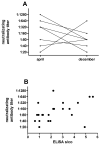SARS-CoV-2 Seroprevalence in Healthcare Workers in Germany: A Follow-Up Study
- PMID: 33922895
- PMCID: PMC8123190
- DOI: 10.3390/ijerph18094540
SARS-CoV-2 Seroprevalence in Healthcare Workers in Germany: A Follow-Up Study
Abstract
SARS-CoV-2 is a worldwide challenge for the medical sector. Healthcare workers (HCW) are a cohort vulnerable to SARS-CoV-2 infection due to frequent and close contact with COVID-19 patients. However, they are also well trained and equipped with protective gear. The SARS-CoV-2 IgG antibody status was assessed at three different time points in 450 HCW of the University Hospital Essen in Germany. HCW were stratified according to contact frequencies with COVID-19 patients in (I) a high-risk group with daily contacts with known COVID-19 patients (n = 338), (II) an intermediate-risk group with daily contacts with non-COVID-19 patients (n = 78), and (III) a low-risk group without patient contacts (n = 34). The overall seroprevalence increased from 2.2% in March-May to 4.0% in June-July to 5.1% in October-December. The SARS-CoV-2 IgG detection rate was not significantly different between the high-risk group (1.8%; 3.8%; 5.5%), the intermediate-risk group (5.1%; 6.3%; 6.1%), and the low-risk group (0%, 0%, 0%). The overall SARS-CoV-2 seroprevalence remained low in HCW in western Germany one year after the outbreak of COVID-19 in Germany, and hygiene standards seemed to be effective in preventing patient-to-staff virus transmission.
Keywords: COVID-19; SARS-CoV-2; healthcare workers; hygiene standards; seroprevalence.
Conflict of interest statement
OW has received research grants for clinical studies, speaker’s fees, honoraria, and travel expenses from Amgen, Alexion, Astellas, Basilea, Biotest, Bristol-Myers Squibb, Correvio, Chiesi, Gilead, Hexal, Janssen, Dr. F. Köhler Chemie, MSD, Novartis, Roche, Pfizer, Sanofi, TEVA and UCB. The other authors declared no conflict of interests.
Figures



References
MeSH terms
LinkOut - more resources
Full Text Sources
Medical
Miscellaneous

